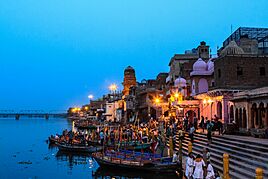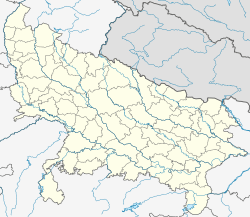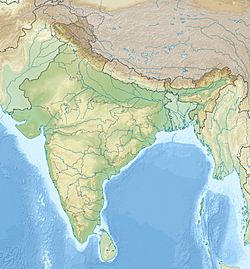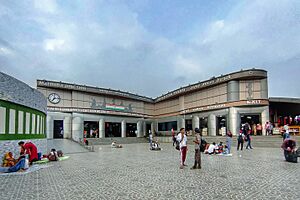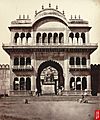Mathura facts for kids
Quick facts for kids
Mathura
|
|
|---|---|
|
City
|
|
|
|
|
| Nickname(s):
Krishnanagri; The City of Lord Krishna
|
|
| Country | |
| State | Uttar Pradesh |
| District | Mathura |
| Division | Agra |
| Government | |
| • Type | Municipal Corporation |
| • Body | Mathura-Vrindavan Municipal Corporation |
| Area | |
| • Total | 39 km2 (15 sq mi) |
| Population
(2011)
|
|
| • Total | 441,894 |
| • Density | 11,330/km2 (29,300/sq mi) |
| Language | |
| • Official | Hindi |
| • Additional official | Urdu |
| • Regional | Braj Bhasha |
| Time zone | UTC+5:30 (IST) |
| PIN |
281001
|
| Telephone code | 0565 |
| Vehicle registration | UP-85 |
Mathura is an important city in the Uttar Pradesh state of India. It is located about 57.6 kilometers north of Agra and 146 kilometers south-east of Delhi. Mathura is also close to the towns of Vrindavan and Govardhan. Long ago, Mathura was a busy center for trade. It was located where major caravan routes met. In 2011, about 441,894 people lived in Mathura.
In Hinduism, Mathura is believed to be the birthplace of Krishna. He is one of the main gods in the Hindu religion. The Krishna Janmasthan Temple Complex is built where Krishna is thought to have been born. Mathura is one of the seven holy cities for Hindus, called Sapta Puri. It is also known as Mokshyadayni Tirth. The Kesava Deo Temple was built on the site of Krishna's birthplace, which was an underground prison. Mathura was once the capital of the Surasena kingdom. This kingdom was ruled by Kamsa, Krishna's uncle. Mathura is a key part of the "Krishna circuit," which includes other important places like Vrindavan and Dwarka. Every year, the festival of Krishna Janmashtami is celebrated in Mathura with great joy.
The Government of India has chosen Mathura as one of its heritage cities. This is part of a plan to develop and improve cities with historical importance.
Contents
History of Mathura
Mathura is located in the cultural area of Braj. It has a very old history. Many people believe it is the homeland and birthplace of Krishna. Krishna belonged to the Yadu family. The city is mentioned in the ancient Indian epic, the Ramayana. In this story, Prince Shatrughna defeats a demon and claims the land. This place was first called Madhuvan because it had many trees. Later, it became Madhupura and then Mathura.
The most important pilgrimage site in Mathura is Katra. Today, it is known as Krishna Janmasthan, or "the birthplace of Krishna." Digging at this site has found old pottery and clay items from the 6th century BCE. Remains of a large Buddhist complex, including a monastery, were also found. There were also Jain sculptures from the same time.
Ancient Times
Archaeological digs show that Mathura grew from a village into an important city. This happened during the Vedic age. The earliest findings are from the Painted Grey Ware culture (1100–500 BCE). After that came the Northern Black Polished Ware culture (700–200 BCE). Mathura became important for trade because of its location. It was where the northern trade route met routes to central and western India.
By the 6th century BCE, Mathura became the capital of the Surasena Kingdom. Later, the Maurya empire ruled the city (4th to 2nd centuries BCE). A writer named Megasthenes mentioned Mathura as a great city around 300 BCE. It seems the next dynasty, the Shungas, did not directly control Mathura. No archaeological remains from them have been found there.
The Indo-Greeks might have controlled Mathura between 180 BCE and 100 BCE. An inscription found near Mathura mentions the "Yavana kingdom" in 70 BCE. However, local rulers called the Mitra dynasty were also present then. This might mean they were under the Indo-Greeks.
Indo-Scythian Rulers
After a period of local rule, the Indo-Scythians took over Mathura in the 1st century BCE. Their rulers were called "Northern Satraps." This rule was short-lived. The last major Indo-Scythian ruler was Rajuvula, around 10–25 CE. An inscription from his time mentions that statues of five important heroes were placed in a stone shrine. These heroes were identified as Samkarsana, Vasudev, Pradyumna, Samba, and Aniruddha.
Kushan Empire Era
During the rule of the great Kushans, art and culture in Mathura grew greatly. This period is known for the famous Mathura School of Art. The Kushans took control of Mathura after Rajuvula's time. Mathura became one of their capitals. Mathuran art reached its peak under Kushan emperors like Kanishka the Great, Huvishka, and Vasudeva. Their rule is seen as the Golden Age of Mathura sculpture. In the 3rd century, the Nagas ruled Mathura after the Kushan Empire declined.
Gupta Empire Era
During the rule of Chandragupta Vikramaditya, a beautiful temple dedicated to Vishnu was built at Katra Keshavadeva. The famous poet Kalidasa (4th-5th century CE) wrote about the groves of Vrindavan and Govardhan hill.
A Chinese Buddhist Monk named Faxian visited Mathura around 400 CE. He described the city as a center of Buddhism. He noted that people were well-off and did not kill animals or consume alcohol. He also mentioned that visiting priests were well cared for.
Harsha Empire Era
Another traveler, Xuanzang, visited Mathura in 634 CE. He said the city had twenty Buddhist monasteries and many Hindu temples. He traveled east from Mathura to other regions before returning to the Yamuna river.
Medieval History
In the 11th century, the city was attacked and many of its temples were destroyed by Mahmud of Ghazni in 1018 CE. A new temple was built in 1150 CE to replace the one at Katra. This temple was dedicated to Vishnu. However, this temple was also later destroyed by forces of Qutb al-Din Aibak. It was repaired but was again attacked during the rule of Sikandar Lodi (1489–1517 CE). Sikandar Lodi was known for destroying Hindu temples.
In the 12th century, a minister named Bhatta Lakshmidhara wrote about the holy sites of Mathura. His work is considered important for understanding Hindu pilgrimage.
Later, in the 16th century, a Portuguese visitor noted that most temples in Mathura were in ruins. Only one Hindu temple remained. He saw many pilgrims coming to this temple.
The Keshavadeva temple was rebuilt by Rajah Vir Singh Deo. It was a grand structure. However, the Mughal Emperor Aurangzeb later ordered the destruction of Hindu schools and temples in 1669. In 1670, he specifically ordered the destruction of the Keshavadeva temple. He also changed the city's name to Islamabad for a time.
The destruction of temples led to a decline in Buddhism in Mathura. For centuries, Jains and Hindus found it hard to build new temples without them being destroyed. Many old religious sites were lost. However, some survived through oral stories or by being rebuilt.
Early Modern History
In the 18th century, Raja Jai Singh II visited Mathura and the surrounding holy places. He founded religious centers and celebrated festivals like Holi.
Later, during the Maratha Empire, many people made pilgrimages to holy places in the north. This included the mother of Peshwa Balaji Baji Rao, who visited Mathura and other holy cities for four years.
Religious Heritage
Mathura is a very holy city in Hinduism. It is considered the heart of Brij Bhoomi, which is the land of Krishna. The city of Vrindavan is often called its twin city.
Mathura and its nearby towns have many important historical and religious places:
- The Krishna Janmasthan Temple Complex is a group of temples built around Krishna's birthplace. It includes the Keshav Deva temple and the Garbha Griha shrine.
- The Dwarkadheesh Temple is one of the largest temples in Mathura.
- Other important Hindu sites include the Gita Mandir, Govind Dev temple, ISKCON temple, and Yum Yamuna Temple.
Kankali Tila is an archaeological site that has revealed many Jain artworks. Digs there found evidence of two Jain temples and stupas. Many Jain sculptures and other items were found. These findings show that Jainism was strong in Mathura for about 1,400 years, from the 2nd century BC to the 12th century CE. These sculptures are now kept in the Lucknow State Museum and the Mathura Museum.
The Mathura Museum is famous for its archaeological items. It has many sculptures from the Kushan and Gupta periods. These sculptures are related to Hinduism, Buddhism, and Jainism.
Festivals
Krishna Janmashtami is a huge festival celebrated every year in Mathura. About 3 to 3.5 million people visit Mathura for Janmashtami. Many go to the Keshav Deva temple and the Dwarkadheesh temple. People often fast and break their fast at midnight, which is when Krishna is believed to have been born. Devotional songs, dances, and prayers happen all over Mathura-Vrindavan.
Culinary Tradition
Mathura and Vrindavan are known for their special local foods. Mathura is famous for its sweet Mathura Peda. Other popular foods include Mathura Lassi, Mathura Heeng Kachori, Mathura Chaat, Moong Dal Cheela, Bedmi puri, and Dubki Aloo Jhol.
Geography and Climate
Mathura is located at 27.28° N latitude and 77.41° E longitude. It is about 174 meters (570 feet) above sea level.
Climate
Mathura has a hot semi-arid climate. This means it has hot summers and mild winters.
| Climate data for Mathura (1981–2010, extremes 1974–1995) | |||||||||||||
|---|---|---|---|---|---|---|---|---|---|---|---|---|---|
| Month | Jan | Feb | Mar | Apr | May | Jun | Jul | Aug | Sep | Oct | Nov | Dec | Year |
| Record high °C (°F) | 29.6 (85.3) |
34.1 (93.4) |
40.1 (104.2) |
45.1 (113.2) |
47.1 (116.8) |
47.6 (117.7) |
44.6 (112.3) |
42.7 (108.9) |
40.6 (105.1) |
42.1 (107.8) |
35.1 (95.2) |
30.1 (86.2) |
47.6 (117.7) |
| Mean daily maximum °C (°F) | 21.3 (70.3) |
24.4 (75.9) |
30.4 (86.7) |
36.6 (97.9) |
41.2 (106.2) |
41.2 (106.2) |
36.1 (97.0) |
34.6 (94.3) |
34.2 (93.6) |
33.3 (91.9) |
29.1 (84.4) |
23.3 (73.9) |
32.1 (89.8) |
| Mean daily minimum °C (°F) | 6.4 (43.5) |
8.3 (46.9) |
13.2 (55.8) |
17.9 (64.2) |
23.9 (75.0) |
25.9 (78.6) |
25.5 (77.9) |
25.0 (77.0) |
23.5 (74.3) |
18.3 (64.9) |
11.6 (52.9) |
7.7 (45.9) |
17.3 (63.1) |
| Record low °C (°F) | 1.0 (33.8) |
0.5 (32.9) |
5.0 (41.0) |
7.0 (44.6) |
8.5 (47.3) |
17.0 (62.6) |
11.5 (52.7) |
17.5 (63.5) |
17.6 (63.7) |
11.5 (52.7) |
4.0 (39.2) |
2.0 (35.6) |
0.5 (32.9) |
| Average rainfall mm (inches) | 10.4 (0.41) |
13.6 (0.54) |
6.8 (0.27) |
10.1 (0.40) |
17.8 (0.70) |
35.5 (1.40) |
164.7 (6.48) |
205.2 (8.08) |
105.0 (4.13) |
18.0 (0.71) |
3.9 (0.15) |
9.0 (0.35) |
600.1 (23.63) |
| Average rainy days | 0.9 | 1.3 | 1.0 | 0.9 | 1.5 | 3.0 | 9.0 | 9.1 | 4.9 | 0.9 | 0.3 | 1.1 | 33.9 |
| Average relative humidity (%) (at 17:30 IST) | 65 | 59 | 53 | 48 | 39 | 43 | 67 | 72 | 71 | 63 | 56 | 60 | 58 |
| Source: India Meteorological Department | |||||||||||||
People of Mathura
| Religions in Mathura City (2011) | ||||
|---|---|---|---|---|
| Religion | Percent | |||
| Hinduism | 81.54% | |||
| Islam | 17.22% | |||
| Others† | 1.24% | |||
In 2011, the population of Mathura was about 441,894 people. This was a 22.53% increase in ten years. About 54% of the population were males and 46% were females. For every 1000 males, there were 858 females. This number has increased since 2001.
Mathura's population density was 761 people per square kilometer in 2011. The average literacy rate was 72.65%. This means most people can read and write. However, it is still a bit lower than the national average of 74.04%. About 15.61% of Mathura's population is under 6 years old.
Languages Spoken
According to the 2011 census, most people in Mathura (95.4%) speak Hindi. About 2.6% speak Urdu, and 1.4% speak Braj Bhasha. Braj Bhasha is the local dialect. The city is part of the cultural region of Braj.
Getting Around Mathura
Train Travel
Mathura Junction railway station is on the main train route between Delhi and Mumbai. Both Central Railway and Western Railway lines pass through Mathura. Trains from north-central India to eastern India also go through Mathura Junction. Mathura Cantt railway station is another important station.
Road Travel
Mathura has good road connections to the rest of India. National Highway 19 (formerly NH-2) from Delhi to Kolkata passes through Mathura. The Yamuna Expressway also goes through Mathura. This highway connects Greater Noida to Agra and provides good links to other cities like Kanpur and Lucknow.
Tram Service
There is a plan to build a tram network in Mathura. If this happens, Mathura would be one of the few cities in India with a working tram system. Local leaders have announced that trams might be running in Mathura and Vrindavan soon.
Air Travel
Currently, Mathura does not have its own airport. The closest airports are Agra Airport (about 60 km away) and Delhi Airport (about 160 km away). These airports offer many national and international flights. A new airport, Jewar Airport, is being built near Greater Noida. It will be about 75 km from Mathura. This airport is expected to be one of the largest in India when it is finished.
Industries
The Mathura Refinery is located in the city. It is one of the largest oil refineries in Asia. It can process 8.0 million tonnes of oil each year. This refinery, run by Indian Oil Corporation Ltd., uses advanced technology. It provides many jobs for local people. Its main goal is to meet the fuel needs of the NCR. The refinery has also worked on projects to reduce sulfur levels in its diesel and gasoline.
Media and Communications
The city has a local radio station called All India Radio.
Educational Institutions
Mathura is home to several educational institutions:
- GLA University
- Sachdeva Institute of Technology
- Sanskriti University
- U.P. Pt. Deen Dayal Upadhyaya Veterinary Science University and Cattle Research Institute
Images for kids
-
Statue of Kanishka I, 2nd century CE, Mathura Museum.
-
.
Sculpture of a woman from ancient Braj-Mathura, around 2nd century CE.
See also
 In Spanish: Mathura para niños
In Spanish: Mathura para niños


